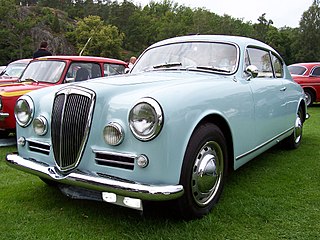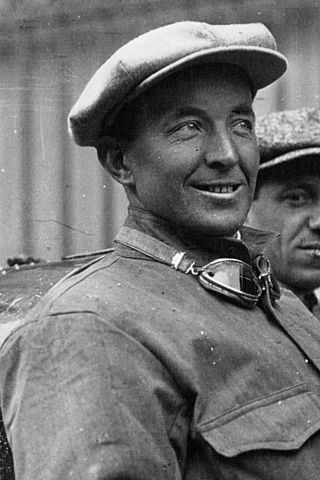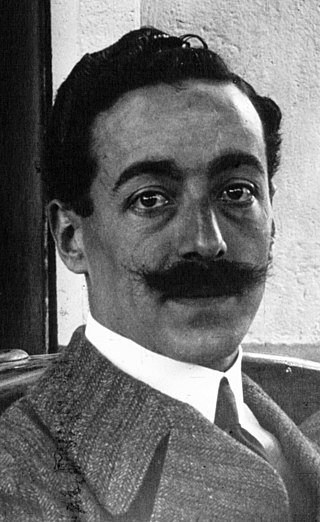
A grand tourer (GT) is a type of car that is designed for high speed and long-distance driving, due to a combination of performance and luxury attributes. The most common format is a front-engine, rear-wheel-drive two-door coupé with either a two-seat or a 2+2 arrangement. Grand tourers are most often the coupé derivative of luxury saloons or sedans. Many iconic car models, such as the Ferrari 250 GT, Jaguar E-Type, and Aston Martin DB5, are considered classic examples of gran turismo cars.

In automotive design, an RMR, or rear mid-engine, rear-wheel-drive layout is one in which the rear wheels are driven by an engine placed with its center of gravity in front of the rear axle, and thus right behind the passenger compartment. Nowadays more frequently called 'RMR', to acknowledge that certain sporty or performance focused front-engined cars are also "mid-engined", by having the main engine mass behind the front axle, RMR layout cars were previously just called MR, or mid-engine, rear-wheel-drive layout), because the nuance between distinctly front-engined vs. front mid-engined cars often remained undiscussed.

Vittorio Jano was an Italian automobile designer of Hungarian descent from the 1920s through 1960s.

Piercarlo Ghinzani is a former racing driver from Italy. He currently manages his own racing team, Team Ghinzani, which was created in 1992 and is currently involved in several Formula Three championships.

Pietro Bordino was an Italian racecar driver.

Caleb Smith Bragg was an American racing driver, speedboat racer, aviation pioneer, and automotive inventor. He participated in the 1911, 1913 and 1914 Indianapolis 500. In speedboat racing, Caleb won three consecutive APBA Challenge Cup races in Detroit from 1923 to 1925. He was a co-inventor of the Bragg-Kliesrath brake.

The Eagle Mk1, commonly referred to as the Eagle T1G, was a Formula One racing car, designed by Len Terry for Dan Gurney's Anglo American Racers team. The Eagle, introduced for the start of the 1966 Formula One season, is often regarded as being one of the most beautiful Grand Prix cars ever raced at the top levels of international motorsport. Initially appearing with a 2.7L Coventry Climax inline 4-cylinder engine, the car was designed around a 3.0L Gurney-Weslake V12 which was introduced after its first four races. In the hands of team boss Gurney, the Eagle-Weslake won the 1967 Belgian Grand Prix, making Dan Gurney only the second driver at the time, and one of only three to date, to win a Formula One Grand Prix in a car of their own construction. Excluding the Indianapolis 500, that win in Belgium still stands as the only win for a USA-built car as well as one of only two wins of an American-licensed constructor in Formula One. It was also the first win for an American constructor in a Grand Prix race since the Jimmy Murphy's triumph with Duesenberg at the 1921 French Grand Prix.
The 1906 Grand Prix season is regarded as the first Grand Prix racing season. It marked the advent of two iconic races: The French Grand Prix and the Targa Florio.

The 1908 Grand Prix season was the third Grand Prix racing season. An international economic recession affected motor-racing with fewer races and smaller fields. However, in consequence, it also saw an increase in the number of smaller cars and voiturette racing. This gave close racing between the teams from Lion-Peugeot, Sizaire-Naudin and Delage. Both the major races in Europe, the Targa Florio and French Grand Prix, had precursor voiturette races, and along with the Coupe des Voiturettes, the honours were shared between those three manufacturers. This year’s Targa Florio had a small, but quality, field. Vincenzo Trucco won for Isotta-Fraschini with better mechanical reliability, after a close duel with the FIATs of Felice Nazzaro and Vincenzo Lancia.
The 1911 Grand Prix season consisted of Grand Prix races in the United States and Europe. It was a significant year as European racing gradually came out of the doldrums. A Grand Prix was held in France again. The first Indianapolis 500 was held at Indianapolis Motor Speedway, joining the American Grand Prize as a leading race.
The 1912 Grand Prix season saw Grand Prix motor racing in Europe and the United States. The growing economic confidence and interest from car manufacturers saw bigger fields and more races in the season. The French Grand Prix was held for the first time since 1908 and staged at Dieppe. The American Grand Prize was held in Milwaukee, moving from its previous home in Savannah.

The 1914 French Grand Prix was a Grand Prix motor race held at Lyon on 4 July 1914. Hailed as one of the greatest races of the twentieth century, it was a contest between the French Peugeots and the German Mercedes. For the first time, the Grand Prix was run to an engine limitation – of 4.5L maximum capacity. It was won by the Mercedes of Christian Lautenschlager who won at an average speed of 105.7 km/h (65.7 mph) after a tense seven-hour contest with the Peugeot of Georges Boillot.

The 1922 Grand Prix season had several notable events during the year. The AIACR governing body brought in a 2-litre formula for Grand Prix. French companies brought out straight-8 engines for their cars but it was FIAT's 6-cylinder engine that took the trophies. Veteran Felice Nazzaro won the French Grand Prix, held near Strasbourg. It was a tainted victory though, as Nazzaro's nephew was killed when his FIAT's suspension broke in the latter stages of the race. An almost identical accident also happened to team-mate Pietro Bordino, though he was only slightly injured. Pierre de Vizcaya's Bugatti finished second, nearly an hour behind.

The 1923 Grand Prix season was part of a watershed year for motor racing that saw significant advances in motor-racing engineering, design and events. Fiat's chief designer, Guido Fornaca, developed the 805, the first supercharged car to win a Grand Prix. Benz appeared with the first mid-engined racer and, along with Bugatti and Voisin, produced some of the first efforts at aerodynamics on racing cars. With the United States also adopting the 2-litre formula, Harry Miller could use the smaller engine size to design the first single-seater race-car, ideally suited to American oval racing.

The 1909 Grand Prix season was the fourth Grand Prix racing season. There were no Grandes Épreuves that year, as the economic recession of the previous year continued on. Renault had withdrawn from motor-racing and a number of French manufacturers, falling behind the success of their German and Italian rivals, followed suit. The French Grand Prix was cancelled, leaving the Targa Florio in Italy and Vanderbilt Cup in the United States as the only major races this season. With so little competition and financial incentive, technological advances ground to a halt. Emphasis shifted from racing to setting speed and endurance records. Benz & Cie built a new 12.4-litre racing-engine, and its 200 bhp derivative was put into the Blitzen Benz. This 21.5-litre monster held the Land speed record from 1909 to 1922, with various drivers starting with Victor Hémery in November, 1909 at Brooklands.

Alessandro Umberto Cagno, Umberto Cagno, nicknamed Sandrin was an Italian racing driver, Aviation pioneer and powerboat racer.

Ernest Henry was a mechanical engineer. He developed auto racing engines, and is especially well known for his work for Peugeot and Ballot, who dominated Grand Prix auto racing from 1912 to 1921. His engine design directly influenced Sunbeam Racing cars as early as 1914; the 1921 Grand Prix Sunbeams owe much to his work with Ballot and the 1922 Grand Prix Sunbeams were designed by him.

The Fiat 130 HP is a Grand Prix racing car made by Fiat in 1907 to a design by Giovanni Enrico. Built solely for Grand Prix motor racing, the Fiat 130 HP included new design features, such as overhead valves and hemispherical compression chambers.

The Fiat 28-40 HP, also known as the Fiat Targa Florio Corsa, is a Grand Prix racing car manufactured by Fiat in 1906 and 1907. From 1907 through 1910, the design evolved into commercial production vehicles, including cars, light trucks, and buses.
This article gives a general overview of motorsport in Italy. For a more exhaustive view see; Motorsport in Italy by decade and Motorsport in Italy by year. Motorsport is widely popular in Italy, and its history spans over a century back to the early 1900s. Today, Italy is considered a hub of motorsport in terms of racing venues, drivers, teams, and manufacturers. It hosts annual races across Formula One, MotoGP, the World Touring Car Cup, and other prominent motor racing series.

















